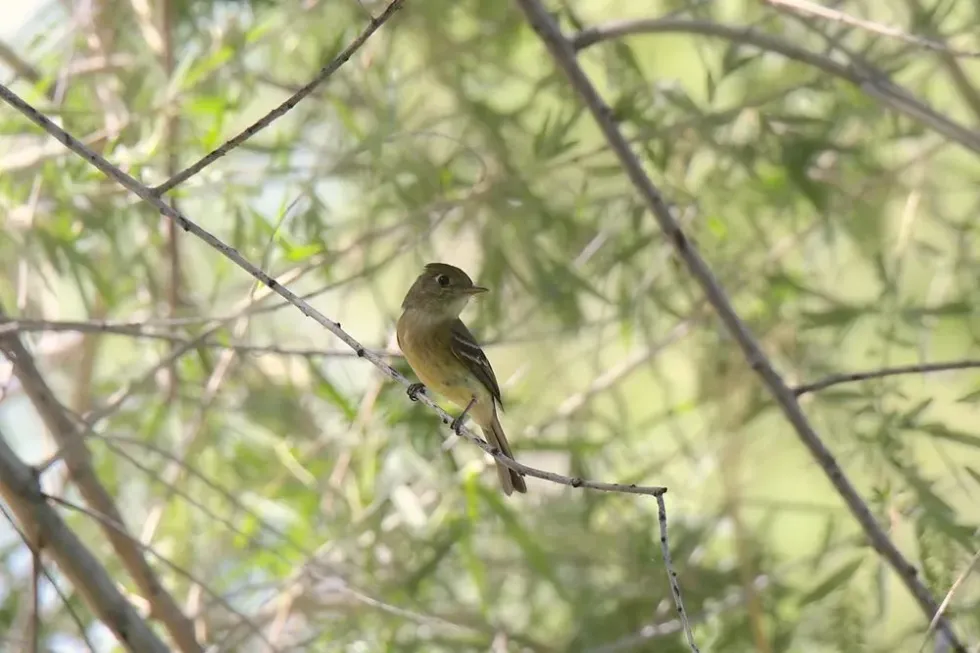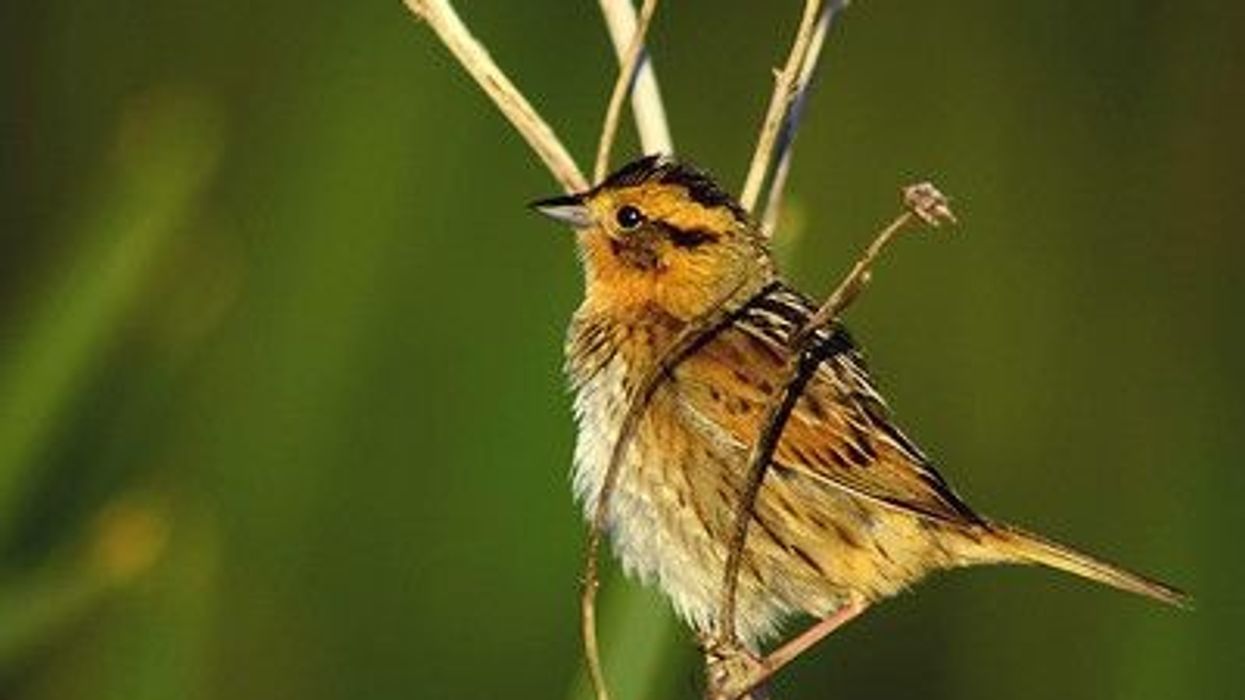The Cordilleran flycatcher, Empidonax occidentalis, is a stunning bird of the order Passeriformes, family Tyrannidae, and the genus Empidonax. It is quite similar to the Pacific-slope flycatcher species.
Cordilleran and Pacific-slope flycatchers are almost identical with only slight variations. They can be differentiated by subtle variations in their voice, feathers, and body size. They were once a single species, known commonly as the western flycatcher, but were separated into two species in 1989.
However, even their calls are quite similar with the only difference being the position of different notes. Both of these similar species are found across North America.
This bird is stunning and small in size, having a length range of 5.5-6.7 in (13.9-17 cm), and a weight range of 0.3-0.4 oz (9-12 g). This flycatcher has a breast that is olive-gray colored, upperparts that are olive-brownish colored, and its belly and throat are yellow in color, along with a white-colored teardrop-shaped ring around each eye.
This bird has a broad and long black-colored bill with its jaw being a striking yellow color. These spectacular birds, found across North America, are spotted mainly in the forest of Eastern Cascade and Sierra Nevada mountain ranges and feed mainly upon insects, seeds, and berries.
Their populations range from Alaska to California, including Mexico.
These birds prefer coniferous forests for breeding and their conservation status as per the IUCN is Least Concern. Keep reading to discover astonishing facts about these North American birds' breeding, habitat, communication, and much more!
If you enjoyed reading about the Cordilleran flycatcher, you'll surely want to read about the scissor-tailed flycatcher and the great crested flycatcher too.
Cordilleran Flycatcher Interesting Facts
What type of animal is a Cordilleran flycatcher?
The Cordilleran flycatcher, Empidonax occidentalis, is a bird that is very similar to the Pacific-slope flycatcher in appearance. These two species, known as the western flycatcher before being separated, can only be distinguished by subtle differences in their range, breeding habitat, and voice.
These species belong to the order Passeriformes, family Tyrannidae, and genus Empidonax, containing 15 species. They are forest-dwelling birds that feed mainly upon insects.
What class of animal does a Cordilleran flycatcher belong to?
The Cordilleran flycatcher (Empidonax occidentalis) belongs to the class of Aves and the family Tyrannidae, which includes similar birds like the famous least flycatcher bird and the vermillion flycatcher bird.
How many Cordilleran flycatchers are there in the world?
This flycatcher bird species has a broad range with a population size of 2,900,000 birds!
Where does a Cordilleran flycatcher live?
These North American birds reside in a wide range of locations, from California to Alaska including Mexico. Their habitat in the western United States comprises forests in mountains. The furthest eastern location that this species inhabits is the Black Hills, South Dakota.
What is a Cordilleran flycatcher's habitat?
This species of North American birds inhabits coniferous forests in mountains. This species can inhabit humid as well as dry, tropical, subtropical, or temperate forests.
These forest-dwelling birds construct their cup-shaped nest at a location where there is water nearby. These birds of North America are also migratory in nature so they spend their summer season near and in the mountains of the western USA and Mexico. They are also known to spend the winter season in Mexico.
Who do Cordilleran flycatchers live with?
This bird is not a colony-nesting bird and they are often spotted foraging in pairs or alone.
How long does a Cordilleran flycatcher live?
The maximum known lifespan of these birds is six years.
How do they reproduce?
This flycatcher is a breeding bird found in the mountain ranges and forests of the Pacific Coast, starting from California and ending at Alaska, that is monogamous. They are observed to reproduce in the summer season in a coniferous or pine-oak forest.
The nest is constructed near water in a fallen tree, the bottom part of the tree, below a bridge, or in a shed, and is constructed with roots, grass, lichens, moss, and leaves. It is further lined with feathers, hair, or fibers.
The female flycatcher lays three to four eggs (rarely five eggs) that are whitish and possess brown spots at the bottom. The eggs are incubated by females of this species which goes on for 14-15 days.
After hatching, male, as well as female flycatchers, provide for their young. After 14-18 days, the nestlings take their first flight.
What is their conservation status?
This species, like most of the members of their family Tyrannidae, has a Least Concern conservation status as they are abundant across their range. However, their population trend is declining, but not at a fast enough rate to classify this species as Vulnerable.
Cordilleran Flycatcher Fun Facts
What do Cordilleran flycatchers look like?
This stunning species of birds is very much similar to the beautiful Pacific-slope flycatchers, so similar that it gets tough to distinguish the Cordilleran species from the Pacific-slope flycatcher species. These small birds have a length ranging between 5.5-6.7 in (13.9-17 cm).
Their upperparts are olive-gray colored, with darker tips on their wings and tail. Around their eye is a teardrop-shaped ring that is white in color. Their tail is quite short and their bills are broad yet small.
How cute are they?
If you found the Pacific-slope flycatcher mesmerizing, you'll find this species adorable as well because of their extreme similarity in appearance. These birds are lovely with an earthy-toned plumage.
How do they communicate?
Their calls are distinct and loud with the song being high-pitched and sounding like 'whee-seet'. The notes in their song include repeated 'pstick', 'pset', and 'pseet'.
How big is a Cordilleran flycatcher?
This bird ranges between 5.5-6.7 in (13.9-17 cm) in length and has a wingspan of 8.7 in (23 cm). They are approximately the same length as the lark sparrow.
How fast can a Cordilleran flycatcher fly?
The speed of this species of flycatchers is not yet evaluated. However, they are prey upon insects and are known to be great fliers that catch their prey in the air. Their flight comprises shallow wing beats.
How much does a Cordilleran flycatcher weigh?
The weight of this species ranges between 0.38-0.44 oz (9-12 g).
What are their male and female names of the species?
There are no particular names for males and females of this species.
What would you call a baby Cordilleran flycatcher?
A baby of these birds would be referred to as a chick, nestling, or hatchling.
What do they eat?
They primarily feed upon insects like bees, caterpillars, flies, wasps, beetles, moths. They are also known to consume seeds, berries, and spiders.
Their foraging behavior is quite interesting as they stalk their prey from a tall perch and catch them in flight. Predators of these birds are not known, however, their cousin, the Pacific-slope, is preyed upon by squirrels, hawks, jays, and brown-headed cowbirds.
Are they dangerous?
No, these adorable creatures are not dangerous. However, they can be hostile towards people.
Would they make a good pet?
No, this species of birds would not become great pets, as even though they aren't dangerous, they aren't friendly either. They are even illegal to be kept as pets in some areas. However, if you have a tall perch at home, these birds might give you a visit as this is one way to attract flycatchers to your garden!
Did you know...
A group of birds of this species can be knowns as a zapper, zipper, outfield, or swatting of flycatchers.
Flycatchers are typically monogamous, but they might change their partner over the years.
Do they migrate?
Yes, these flycatchers do migrate. They travel to Mexico for the winter season, where the Mexican central-southern birds reside. Birds that are not residents here are present on the west coast.










